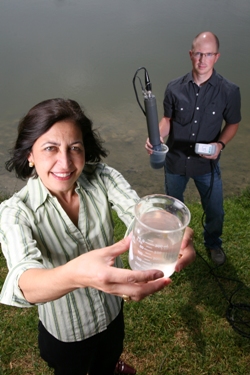A University of Houston environmental engineer will test parts of Galveston Bay for toxic chemicals in an effort to help state officials determine the best way to handle those pollutants.
Hanadi Rifai will conduct the Galveston Bay research project through a Texas Commission on Environmental Quality (TCEQ) grant that is an extension of an award she received last fall for similar research in the Houston Ship Channel. The latest grant increases the total amount awarded for this research to $500,000.
Specifically, Rifai will test certain bodies of water for dioxins, which are highly toxic byproducts of many industrial processes, and polychlorinated biphenyl’s, or PCBs, a class of chemical compounds used in many commercial applications until their production was banned in the U.S. in 1979.
“These pollutants are nasty 21st-century realities that we have to deal with,” Rifai said. “They present a complex challenge because they’re in the air, in the soil and in the water. The pathway of exposure in this particular case is by ingesting contaminated seafood.”
Rifai and her research team will gather water, sediment and marine life samples at various locations in the ship channel and Galveston Bay to identify the source of pollutants and areas in the water and sediment with high concentrations of dioxins and PCBs. Additionally, researchers will determine concentrations of these pollutants in the tissues of marine life, with a focus on prized species such as trout and croaker.
Their findings likely will be used by the TCEQ to determine the best way to manage these pollutants. Possible actions include bioremediation techniques that essentially neutralize the harmful chemicals and commercial fishing bans in certain areas. Sediment removal is also a possibility, Rifai said, though that method has stirred up pollutants in the sediment in certain areas, resulting in more harmful chemicals being released into the water.
By expanding this research effort, the TCEQ is signaling that it will likely invest more resources into dioxin and PCB research and remediation during the next few years, Rifai said.
“The state wants to take a holistic view of all the state waters and figure out what’s going on with dioxin and PCBs,” she said. “The expanded scope of this grant is a sign that they are actually going to do this, and researchers are going to get the resources to make it happen.”
Rifai and her team have had success in locating pollutants in some Houston-area waters. Her team was instrumental in locating a former waste site at Interstate 10 and the San Jacinto River that was the source of significant dioxin pollution. That area is now an EPA Superfund cleanup site.
Rifai is a professor in the UH Cullen College of Engineering’s civil and environmental engineering department and director of the environmental engineering graduate program. She also is co-director of the Severe Storm Prediction, Education and Evacuation from Disasters (SSPEED) Center, a consortium involving several universities. At SSPEED, her efforts are largely focused on developing an understanding of what is at risk in the ship channel in light of hurricanes and severe storms that affect the region.
About the University of Houston
The University of Houston is a Carnegie-designated Tier One public research university recognized by The Princeton Review as one of the nation’s best colleges for undergraduate education. UH serves the globally competitive Houston and Gulf Coast Region by providing world-class faculty, experiential learning and strategic industry partnerships. Located in the nation’s fourth-largest city, UH serves more than 38,500 students in the most ethnically and culturally diverse region in the country.
